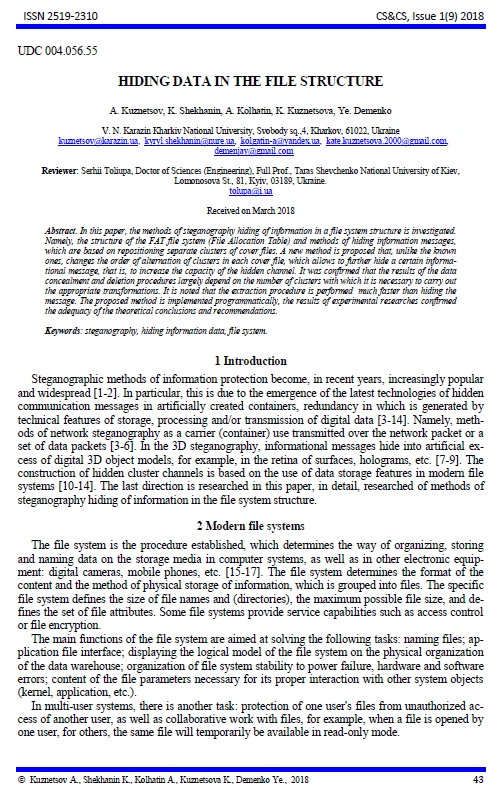Приховування даних в файлової структурі
Анотація
У статті досліджуються методи стеганографії, що приховують інформацію в структурі файлової системи. А саме, структура файлової системи FAT (таблиця розподілу файлів) і методи приховування інформаційних повідомлень, що засновані на зміні положення окремих кластерів файлів обкладинки. Пропонується новий метод, який, на відміну від відомих, змінює порядок слідування кластерів в кожному файлі обкладинки, що дозволяє додатково приховати інформаційне повідомлення, тобто збільшити ємність прихованого каналу. Підтверджено, що результати процедур приховування та вилучення даних в значній мірі залежать від кількості кластерів, з якими необхідно провести відповідні перетворення. Відзначено, що процедура вилучення виконується набагато швидше, ніж приховування повідомлення. Пропонований метод реалізований програмно, а результати експериментальних досліджень підтверджують правильність теоретичних висновків і рекомендацій.
Завантаження
Посилання
S. Katzenbeisser, F. A. Petitcolas. Information Hiding Techniques for Steganography and Digital Watermarking, Norwood, MA, USA: Artech House, 2000, 220 p.
F. A. P. Petitcolas, R. J. Anderson and M. G. Kuhn. "Information hiding-a survey," in Proc. of the IEEE, Vol. 87, No. 7, pp. 1062-1078, Jul 1999.
W. Mazurczyk, M. Smolarczyk, K. Szczypiorski. "Retransmission steganography and its detection", Soft Computing, Vol. 15, No. 3, pp. 505-515, 2011.
S. Nair, A. Kumar, A. Sur and S. Nandi. "Length based network steganography using UDP protocol". 2011 IEEE 3rd Int. Confer-ence on Communication Software and Networks, Xi'an, 2011, pp. 726-730.
K. Ahsan and D. Kundur. "Practical data hiding in TCP lIP", In: ACM Workshop on Multimedia and Security, 2002, [On-line]. Internet: http://ee.tamu.edu/deepalpdf/acm02.pdf
S. H. Sellke, C. Wang, S. Bagchi, and N. B. Shroff. "TCP/IP Timing Channels: Theory to Implementation", pp. 2204-2212, 2009.
V. Itier, W. Puech and A. G. Bors. "Cryptanalysis aspects in 3-D watermarking". 2014 IEEE International Conference on Image Processing (ICIP), Paris, 2014, pp. 4772-4776.
Yang, Qin, Liujie, Sun, and Wenju, Wang. "A robust watermarking scheme for 3D models based on encrypted holographic algo-rithm". Proceedings of 2015 International Conference on Intelligent Computing and Internet of Things, Harbin, 2015, pp. 85-89.
Z. Li, S. Beugnon, W. Puech, and A. G. Bors. "Rethinking the high capacity 3D steganography: Increasing its resistance to ste-ganalysis". 2017 IEEE (ICIP), Beijing, 2017, pp. 510-414.
S. F. Liu, S. Pei, X. Y. Huang, and L. Tian. "File hiding based on FAT file system". 2009 IEEE International Symposium on IT in Medicine & Education, Jinan, 2009, pp. 1198-1201.
J. Davis, J. MacLean and D. Dampier. "Methods of Information Hiding and Detection in File Systems". 2010 Fifth IEEE Interna-tional Workshop on Systematic Approaches to Digital Forensic Engineering, Oakland, CA, 2010, pp. 66-69.
H. Khan, M. Javed, S.A. Khayam, F. Mirza. “Designing a cluster-based covert channel to evade disk investigation and forensics”. Computers & Security, Vol. 30, Issue 1, January 2011. [On-line]. Internet: https://www.sciencedirect.com/science/article/pii/S016740481000088X
H. Khan, M. Javed, S.A. Khayam, F. Mirza. “Evading Disk Investigation and Forensics using a Cluster-Based Covert Channel”. National University of Science & Technology (NUST), Islamabad 44000, Pakistan. [On-line]. Internet: https://www.sigsac.org/ccs/CCS2009/pd/abstract_17.pdf
N. Morkevičius, G. Petraitis, A. Venčkauskas, J. Čeponis. “Covert Channel for Cluster-based File Systems Using Multiple Cover Files”. Information Technology and Control, 2013, Vol. 42, No.3. pp. 32. [On-line]. Internet: http://itc.ktu.lt/index.php/ITC/article/view/3328 .
L. Yang, P. Chen, G. Zhu, and L. Yu. "Repairing algorithm design for FAT file system in embedded system". 2011 International Conference on Consumer Electronics, Communications and Networks (CECNet), XianNing, 2011, pp. 3393-3396.
Z. Jinhai. "Research of embedded FAT file system". 2011 International Conference on Uncertainty Reasoning and Knowledge Engineering, Bali, 2011, pp. 44-47.
H. Zhao, X. Li, L. Chang, and X. Zang, "Fat File System Design and Research". 2015 International Conference on Network and Information Systems for Computers, Wuhan, 2015, pp. 568-571.


